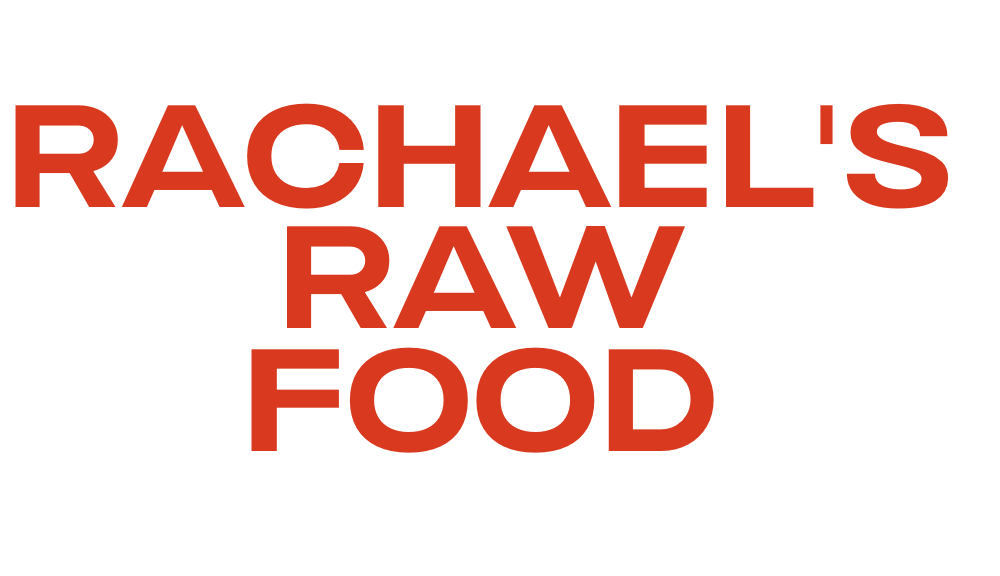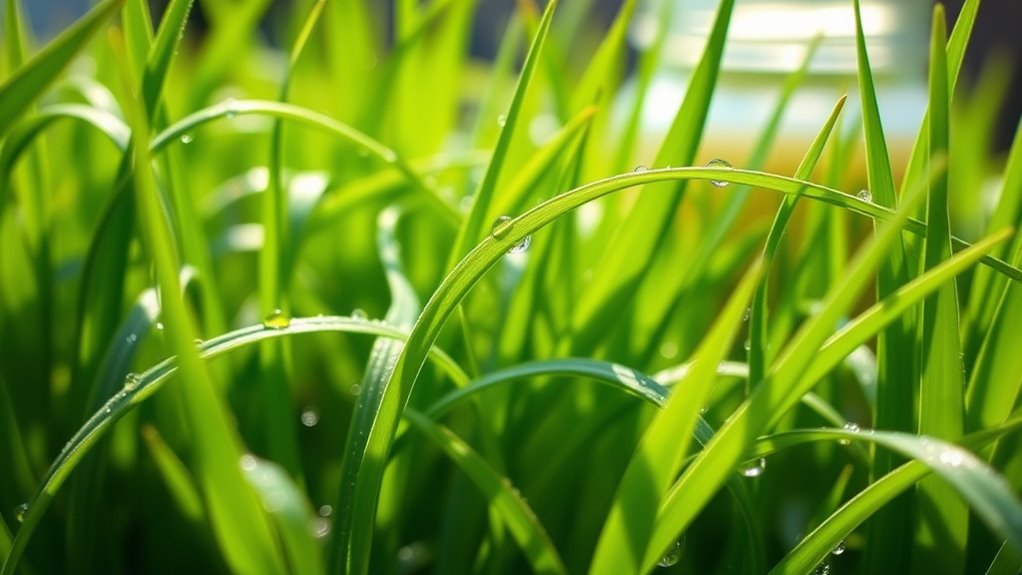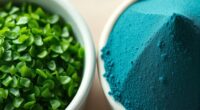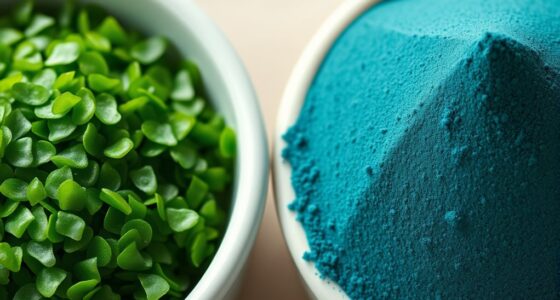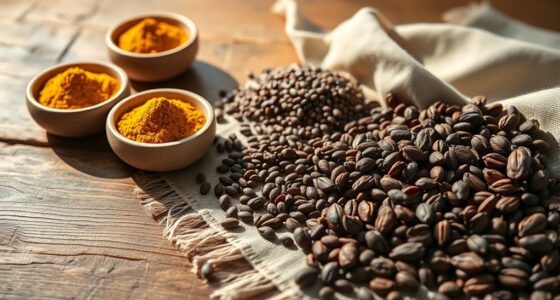Juicing wheatgrass is definitely worth the hype since it packs a powerful punch of nutrients, antioxidants, and chlorophyll that can boost your energy and detoxify your body. Growing your own grass guarantees you get a fresh, chemical-free product loaded with vitamins A, C, E, and essential minerals. When you juice it, you concentrate these benefits. Want to discover more about how to maximize wheatgrass’s health perks? Keep exploring to reveal its full potential.
Key Takeaways
- Wheatgrass juicing provides concentrated nutrients like chlorophyll, vitamins, and minerals that support detoxification and immune health.
- Proper cultivation and harvesting maximize the nutritional content, making fresh juice highly beneficial.
- Juicing offers an efficient way to boost intake of antioxidants and essential nutrients for overall wellness.
- Growing wheatgrass at home ensures a natural, chemical-free product with optimal freshness and potency.
- The health benefits of wheatgrass juice justify its popularity, but individual results may vary based on consumption and quality.
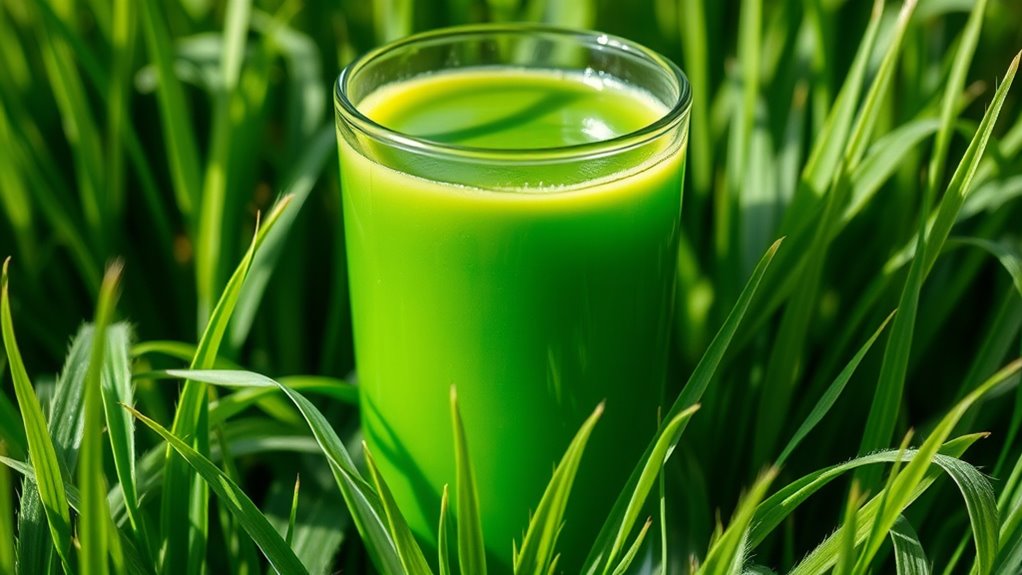
Have you ever wondered why wheatgrass juice is so popular among health enthusiasts? It’s because of the impressive nutritional benefits packed into a small glass. Wheatgrass is rich in chlorophyll, antioxidants, vitamins, and minerals, which can boost your energy levels, support your immune system, and promote overall wellness. Many people turn to wheatgrass juice as a natural way to detox their bodies and improve digestion. But to truly understand its benefits, it helps to know how wheatgrass is grown and harvested. The cultivation techniques are straightforward but crucial to ensure you get the most nutrients from your juice. Wheatgrass is typically grown from sprouted wheat seeds, which can be cultivated indoors or outdoors, depending on your space and climate. The process involves soaking the seeds, allowing them to sprout, and then planting them in soil or hydroponic systems. Proper watering, lighting, and temperature control are essential during growth to produce healthy, nutrient-dense grass. Harvesting usually occurs when the grass reaches about 7 to 10 inches tall, before it starts to flower, as this is when the nutritional content is at its peak. Using sharp scissors, you cut the blades close to the root, ensuring a fresh supply of grass for juicing. The cultivation techniques you choose can influence not only the yield but also the quality of the wheatgrass. Organic growing methods are preferred, as they minimize chemical contamination and preserve the natural nutrient profile. Growing your own wheatgrass at home allows you to control every step, from seed selection to harvest, ensuring maximum nutritional benefits in your juice. Additionally, some Vetted electric bike conversion kits now incorporate advanced motors that can make transporting fresh wheatgrass easier and more efficient. When you juice the wheatgrass, you’re extracting a concentrated dose of nutrients that can profoundly contribute to your daily intake of essential vitamins like A, C, and E, as well as minerals such as magnesium, iron, and calcium. The chlorophyll content, in particular, is thought to detoxify your body and improve oxygen transportation. So, the effort you put into cultivating and juicing wheatgrass directly translates into a potent health boost. Whether you buy it from a store or grow your own, understanding the cultivation techniques helps you appreciate the effort behind every glass. It’s not just about the hype; it’s about harnessing nature’s nutrient-rich powerhouse in a simple, natural form. When you incorporate wheatgrass juice into your routine, you’re tapping into a tradition that has supported health for centuries, now backed by modern nutritional insights.
Frequently Asked Questions
Can Wheatgrass Juice Replace Daily Vegetables?
You might wonder if wheatgrass juice can replace your daily vegetables. While it’s rich in nutrients, its nutritional comparison to a variety of vegetables isn’t complete. Wheatgrass has a strong taste and a fibrous texture that might not satisfy all your palate needs. It’s best to see it as a supplement rather than a full replacement, ensuring you still get diverse vitamins and flavors from your vegetables.
Are There Any Risks Associated With Wheatgrass Juicing?
Think of wheatgrass juicing as sailing through calm waters—generally safe, but beware of hidden rocks. You might face risks like allergic reactions or dental health issues, especially if you consume it excessively or have allergies. Always check for allergy concerns before starting, and consider using a straw to protect your teeth. Staying informed helps you enjoy wheatgrass benefits without steering into trouble.
How Much Wheatgrass Should I Consume Daily?
You should aim for about 1 to 2 ounces of wheatgrass juice daily. This amount supports ideal nutrient absorption, helping your body benefit from its vitamins and minerals. It also aids the detoxification process by flushing out toxins. Start with a small serving to see how your body responds, and gradually increase if you tolerate it well. Remember, moderation ensures you get the benefits without overdoing it.
Is Wheatgrass Juice Suitable for Children?
Did you know that only 10% of parents give their children wheatgrass juice? When considering child safety, it’s best to consult a pediatrician before offering it. Kids may find the taste strong or bitter, affecting their taste preferences. Always start with small amounts, monitor reactions, and prioritize natural, safe options. If well-tolerated, wheatgrass juice can boost nutrients, but safety and taste considerations are key for children.
What Are the Long-Term Health Benefits of Wheatgrass?
You might wonder about the long-term health benefits of wheatgrass. Regular consumption can improve nutrient absorption, helping your body utilize vitamins and minerals more efficiently. It also supports gut health by promoting a healthy digestive system and reducing inflammation. Over time, these benefits can boost your overall vigor, energy, and immune function. Incorporating wheatgrass into your diet could be a natural way to enhance your long-term wellness and maintain good health.
Conclusion
So, after all the fuss about wheatgrass, maybe it’s just grass, after all. You’ve squeezed and sipped, hoping for that miracle boost, only to find it’s little more than green juice. Ironically, all the hype might have you overlooking simpler, more effective ways to stay healthy. Sometimes, nature’s best remedies are right in front of you—no juicing required. So, next time, skip the grass and enjoy the real nourishment life offers.
